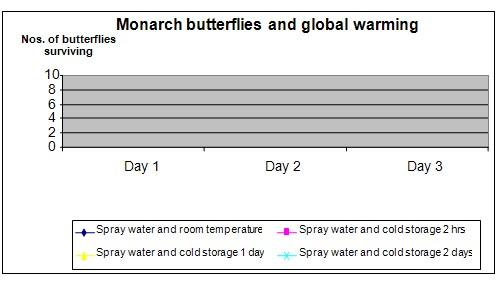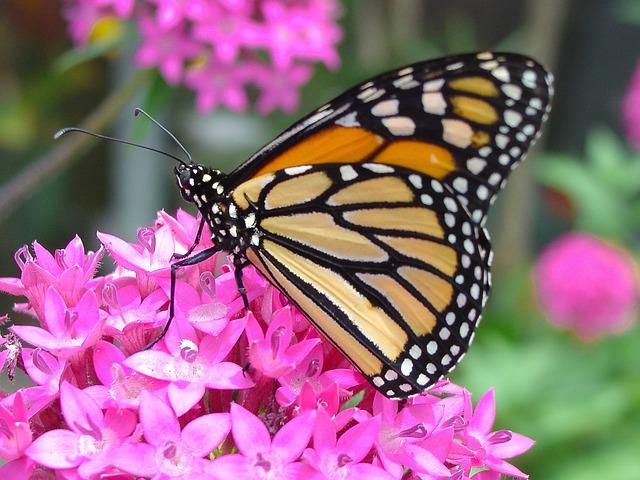| Complexity level: | 9 |
| Project cost ($): | 30 |
| Time required: | 1 day to prepare, 2 days for the science project experiment |
| Material availability: | Easily found |
| Safety concerns: | Basic safety requirements |
Hypothesis
The Monarch butterfly will not be able to survive wet and freezing cold temperatures. If this is indeed true, this may mean that cold and wet weather brought on by global warming, may result in a dwindling Monarch butterfly population.
Overview
Monarch butterfly migration
Every year just before winter, millions of Monarch butterflies travel from the Canadian border to the mountaineous jungles of Mexico to avoid the cold weather in the north. After spending the winter in Mexico, these butterflies will start their journey back up north in spring. Along the way, they will stop over at milkweed fields to lay eggs. When these eggs hatch, the next generation of butterflies will continue their journey back north to the Canadian border.
Recently global warming has caused temperatures world wide to increase. Computer simulations show that over the next 50 years, more rainfall is expected in the Monarch butterflies’ resting ground in Mexico. The increased rainfall and continuous cold weather will cause crystals to form on the butterflies’ wings and eventually lead to the annihilation of a large percentage of the butterfly population. This is what happened in January of 2002, when almost 80% of the Monarch butterflies died in Mexico.
Scientific Terms
Materials
The materials required for this science fair project:
- 4 transparent fish tanks
- 40 Monarch butterflies
- 1 spray bottle
- 1 liter of tap water
- 1 cold storage room
Procedure
1. For this science fair project, the independent variable is the exposure of the Monarch butterflies to sprayed water and cold temperature. The dependent variable is whether the butterflies survive or die. This is determined by observing the butterflies at the end of the science project experiment. The constants (control variables) are the number of butterflies, the amount of water sprayed on the butterflies and the temperature of the cold storage room.
2. The 4 fish tanks are labeled A, B, C and D. Each fish tank is filled with 10 Monarch butterflies.
3. Water is filled into the spray container.
4. On the first day of science fair project, all of the Monarch butterflies in all the 4 tanks are sprayed with water. The wings of the butterflies must be wet thoroughly. This is to simulate rain. After being sprayed with water, the butterflies in each fish tank are exposed to the following conditions :
a. Tank A – the butterflies are allowed to dry out at normal room temperature,
b. Tank B – the butterflies are kept inside the cold storage room for 2 hours,
c. Tank C – the butterflies are kept inside the cold storage room for 1 day, and
d. Tank D – the butterflies are kept inside the cold storage room for 2 days.
The purpose of the cold storage room is to simulate cold weather that comes after the rain.
5. The Monarch butterflies are observed for 3 days to see if they are alive or dead. The number of butterflies alive on each day is recorded in the table below.


Results
You should be able to verify from the data gathered, that all the Monarch butterflies in tank A will survive. Some of the butterflies in tank B (approximately 50%) will survive. And the butterflies in tanks C and D will not survive.
|
Condition |
Number of Monarch butterflies still alive |
|||
|
Day 1 |
Day 2 |
Day 3 |
||
|
A |
Spray water and room temperature |
|||
|
B |
Spray water and cold storage 2 hour |
|||
|
C |
Spray water and cold storage 1 day |
|||
|
D |
Spray water and cold storage 2 days |
Plot your findings in the chart below.
Conclusion
You should be able to prove that your hypothesis is true - that Monarch butterflies will not be able to survive wet and freezing cold temperature. You should observe that the butterflies will die if their wet wings are exposed to freezing temperatures.
Changing weather conditions can be lethal to many fragile living organisms like the Monarch butterflies. Under these circumstances, the butterflies will need to adapt to new weather conditions, and find a new resting place for the winter or risk becoming extinct.
Also consider
What would happen if the science fair project were to be repeated by placing the butterflies inside the cold storage room without wetting their wings first?
The science fair project can be repeated to find out more precisely how many hours or days the Monarch butterflies with wet wings will be able to survive in freezing temperatures.
References
Monarch butterfly - http://en.wikipedia.org/wiki/Monarch_ (butterfly)
Flying into climate change - http://www.scienceline.org/2006/10/23/env-phillips-monarchs/
Monarch butterfly endangered by global warming -http://www.veggieboards.com/boards/showthread.php?11890-monarch-butterfly-endangered-by-global-warming

